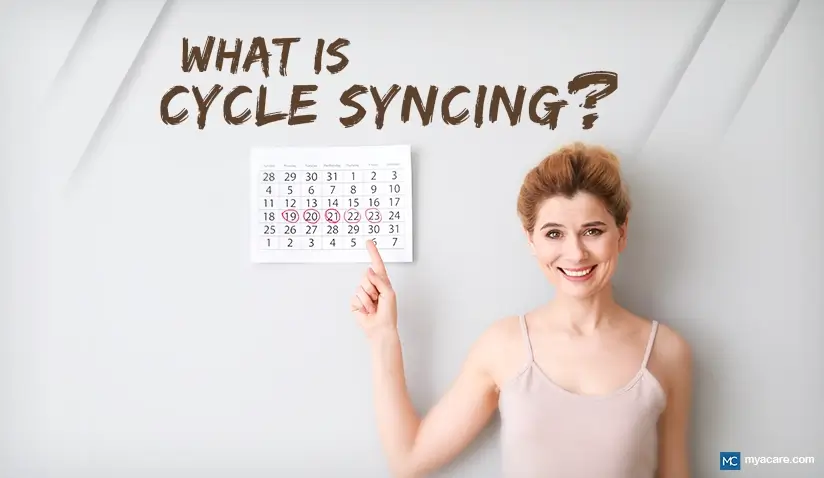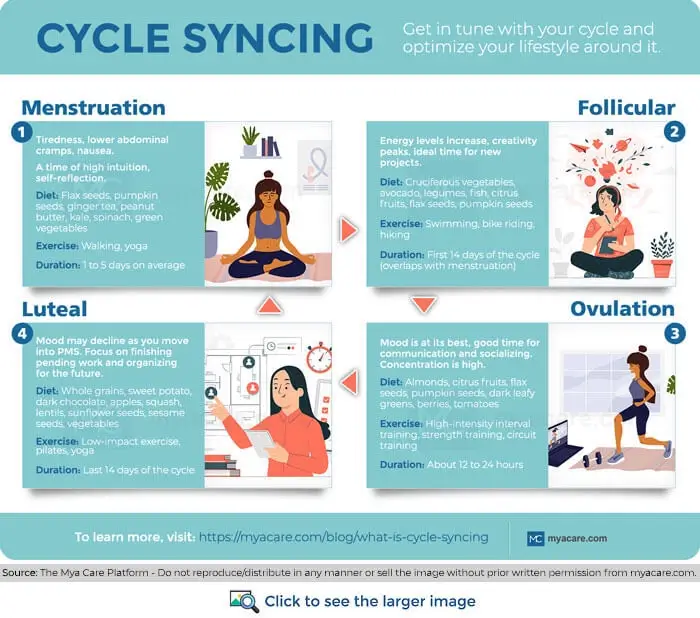What Is Cycle Syncing?

Updated 16 August 2024
Cycle syncing is a way by which women alter their diet and other activities to best match the changes in their menstrual cycle. A recent article in Forbes magazine discussed how cycle syncing could even help women with productivity in the workplace. Read on to learn more about the menstrual cycle and cycle syncing, how to achieve cycle syncing, how it can be used to improve how you feel physically and mentally, and how it can help your productivity at work.
The menstrual cycle
In order to understand how cycle syncing works, it is important to know what happens during each of the phases of the menstrual cycle.
The menstrual cycle consists of four main phases, with each phase lasting a certain amount of time:
The phases and approximate lengths of time they can last are given below:
- Menstruation: about 1 to 5 days on average.
- Follicular: the first 14 days of the cycle.
- Ovulatory: about 12 to 24 hours.
- Luteal: the last 14 days of the cycle.
It is important to realize that the length of each phase can vary, and even menstruation can vary greatly from the average of 28 days. In some women, the cycle may take 21 days, while in others, it can take up to 40 days.
During the cycle, there are several hormonal changes that women experience. To try cycle syncing, you need to carefully record the first day of menstruation and track how your moods and energy change over time to get an idea of when you are going through the different phases.
The menstruation phase
Also referred to as the menstrual phase, this is the time of the month when the inner layer of the uterus, the endometrium, is shed. This causes the monthly bleeding that women experience during their reproductive years. At this time, the estrogen and progesterone hormones are at the lowest concentrations.
A woman may also experience bloating and cramping of the uterus, which can be very painful. Bleeding can also lead to anemia if it is heavy and you are not eating enough iron-rich food. It is also common to feel tired and even irritable at this time.
Follicular phase
This stage overlaps with menstruation and begins simultaneously. During the follicular phase, eggs contained within the follicles on your ovaries begin to develop. The follicles are actually sacs that contain fluid and immature eggs. Only one of about 20 eggs will mature.
The pituitary gland signals the body to secrete more estrogen and follicle-stimulating hormone (FSH) during the follicular phase. The follicular phase after the end of menses (menstruation) is called the proliferative phase because this is when the endometrium starts to develop and thicken. Estrogen increases a lot during the follicular phase. The follicular phase will continue until ovulation occurs.
Ovulatory phase
This phase lasts only a short while, and this is when a mature egg is released. Luteinizing hormone (LH) secreted at this time triggers the release of an egg. The egg will pass down the fallopian tube. The ovulatory phase marks the only time conception is possible during the menstrual cycle. If not fertilized, the egg will simply dissolve.
During this phase, the woman’s body temperature also increases a bit. Estrogen levels are highest at this time, and progesterone also starts increasing.
Luteal phase
The luteal phase is when the follicle that released the egg transforms into a structure called the corpus luteum. This corpus luteum mainly releases progesterone (which now increases dramatically in concentration), but it also produces some estrogen. This increase in hormone concentrations is to help the uterus maintain a thick endometrium for an embryo to implant into if an egg is fertilized.
- If an egg is fertilized, then the endometrium remains thick throughout pregnancy because of human chorionic gonadotropin (hCG), which is secreted.
- If an egg is not fertilized, the corpus luteum shrinks, and the body reabsorbs it. Then, in about 75% of women, premenstrual syndrome (PMS) begins. PMS begins near the end of the luteal phase before entering menstruation.
Less commonly, a woman may experience premenstrual dysphoric disorder (PDD), which includes severe menstrual depression.
How cycle syncing can be helpful
The fluctuations in hormones and physical changes that occur during the phases of the menstrual cycle can make you feel uncomfortable and irritable. Cycle syncing is suggested as a way to use diet and exercise to help you feel your best at each stage, and there are also suggestions for the best strategies to use in the workplace for each phase.

Cycle syncing with the menstruation/menstrual phase
Menstruation can bring period cramps (dysmenorrhea), bloating, tiredness, and nausea. It is important to adjust your diet and exercise accordingly.
Dietary changes recommended during this phase include choosing the following foods:
- Flax seeds and pumpkin seeds: These seeds help to control the estrogen in the body.
- Ginger tea: Ginger is helpful if you feel nauseated during your period.
- Peanut butter: The high magnesium and vitamin B6 content in peanut butter can help alleviate any moodiness at this time.
- Kale, spinach and other green vegetables: These are good sources of calcium and magnesium, helping ease muscle contractions. Period cramps are worse if you have a calcium deficiency. Spinach is also high in iron, which helps replace iron lost during menstruation.
Exercise should be gentle during this phase and can include:
- Walking: This can be very relaxing and helpful during your period.
- Yoga: This is another good choice because it can help you to relax.
Work:
It is thought that your intuition is highest during the menstruation phase, so it is good to listen to your instincts at this time. Self-reflection is also best done during the menstruation phase of the cycle.
Cycle syncing with the follicular phase
Foods to choose during this time helps to replenish energy lost during the previous phase and include:
- Cruciferous vegetables: These are vegetables that are green and leafy and include broccoli and spinach. These also help to replenish lost minerals like iron.
- Avocado: This is helpful if you are trying to get pregnant as it increases fertility.
- Legumes: Beans, peas, and lentils are good foods to add as they are high in fiber and can help estrogen metabolism.
- Fish: A good protein with fatty acids that keep you healthy.
- Citrus: This is a good source of vitamin C and anti-inflammatories.
- Flax and pumpkin seeds: These help with regulating estrogen, a hormone that changes in concentration during your cycle.
Exercises:
- Swimming
- Bike riding
- Hiking
Work:
Energy levels increase during the follicular phase. You may find that creativity is at a high at this point of your cycle, so thinking of new projects or beginning new projects would be good to do during the follicular phase.
Cycle syncing with the ovulatory phase
Ovulation is the shortest stage of the menstrual cycle and is the most important time if you are trying to get pregnant. This is also when your mood will be best.
Foods that will work best during the ovulatory phase:
- Almonds: These nuts are good because they are anti-inflammatory.
- Citrus fruits: These fruits provide fiber and vitamin C to keep your body healthy.
- Flax and pumpkin seeds
- Dark leafy green vegetables: Spinach and other such vegetables contain folate, an important B vitamin that helps improve ovulation.
- Berries: It is a good idea to eat berries because they have anti-oxidants that help keep you healthy.
- Tomatoes: These have lycopene which may help increase fertility.
Exercises you should try during this phase when you have higher energy levels include the following:
- High-intensity interval training: Fast biking and squat jumps are examples of this type of training. These give your body a good workout, including your cardiovascular system. It also helps you build muscle.
- Strength training: Lifting weights helps build and maintain muscle tissue.
- Circuit training: This is a type of training where you do a couple of different exercises for short periods of time.
Work:
This phase is a good time for communication and socializing with people; your concentration is good. This can be a very good time at work for interacting with co-workers.
Cycle syncing with the luteal phase
During the latter part of the luteal phase, PMS can occur. This means being careful about what food you choose to eat and what activities you do. Your mood is more likely to decline nearer the end of this phase as you move into PMS. This is because the estrogen and progesterone levels fall near the end of this phase as you approach menstruation.
The best food choices during the luteal phase are:
- Whole grains: These decrease the production of prostaglandin hormones associated with the corpus luteum; these hormones are linked to the cramps near the end of the luteal phase.
- Sweet potato: A good source of sugar to help soothe a person when they are irritable, which can happen during PMS.
- Dark chocolate: A good source of magnesium to help with muscle cramps and help decrease water retention.
- Apples and squash: These foods are high in nutrients and fiber; apples may help satisfy any sugar cravings.
- Lentils: These are an excellent source of protein that help you keep your strength up.
- Sunflower seeds and sesame seeds: These are useful because they help raise the secretion of progesterone while helping control estrogen levels. They help regulate the hormones.
- Vegetables: Celery and cucumber are a good idea near the end of the phase when you start to retain water during PMS, causing bloating.
Exercises to do include:
- Low-impact exercise: Swimming, cycling, and walking are all low-impact exercises you could try.
- Pilates: This is a useful exercise that also involves certain breathing methods along with movement.
- Yoga: The different postures and breathing techniques of yoga help to relax the body.
Work:
The desire to finish off a project is highest at this stage of the cycle. It is also a good time to finish work and organize and plan properly for future projects or activities.
Conclusion
All women who are menstruating can benefit from cycle syncing. Cycle syncing is designed to help you overcome some of the difficulties associated with the alterations in mood, energy level, and physical changes linked to the phases of the menstrual cycle. Cycle syncing can also benefit you at the workplace.
To search for the best Obstetrics and Gynecology healthcare providers in Germany, India, Malaysia, Poland, Saudi Arabia, Singapore, Slovakia, Spain, Thailand, Turkey, the UAE, the UK and the USA, please use the Mya Care search engine.
To search for the best doctors and healthcare providers worldwide, please use the Mya Care search engine.

Dr. Rae Osborn has a Ph.D. in Biology from the University of Texas at Arlington. She was a tenured Associate Professor of Biology at Northwestern State University, where she taught many courses to Pre-nursing and Pre-medical students. She has written extensively on medical conditions and healthy lifestyle topics, including nutrition. She is from South Africa but lived and taught in the United States for 18 years.
Sources:
Featured Blogs



